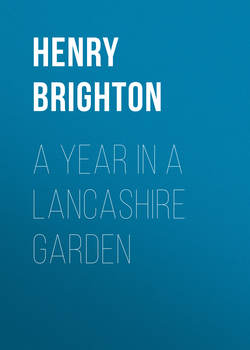Читать книгу A Year in a Lancashire Garden - Henry Brighton - Страница 5
IV
ОглавлениеThe Rookery – Daffodils – Peach Blossoms – Spring Flowers – Primroses – Violets – The Shrubs of Spring.
March 6.– We have a tradition, or, if you will, a superstition, in this part of the world, that rooks always begin to build on the first Sunday in March. Last year my rooks were punctual to a day. This year, although they began a day or two earlier, it was not till the morning of Sunday the 1st that they showed real activity. Then the belt of trees which they frequent, and which for want of any better name we call "our wood," was all alive and clamorous. These rooks are only with us from March to the end of May, and then they are off again for the rest of the year to the woods which cluster thickly round the stately hall of the great nobleman of our county. But they never quite forget their nests among our Elms; and it is pleasant to see them in summer, and oftener still in late autumn, winging their way across the fields, and then wheeling down upon the trees. Who was it, who so happily applied to rooks the lines from the sixth Æneid, where Virgil, speaking of the descent of Æneas and his guide upon the Elysian plains, says
"Devenere locos lætos, et amœna vireta
Fortunatorum nemorum, sedesque beatas"?
"And down they came upon the happy haunts,
The pleasant greenery of the favoured groves —
Their blissful resting-place."
There are many secrets about the rooks which I can never solve. Why do they build in the Elm rather than the Beech? My best trees are Beeches, but there are only two nests in them, whereas in a single Elm there are no less than ten. Why, again, do the old birds prevent the young ones from building in some particular tree? Sometimes, no doubt, there may be an unhappy association of the past, as in a case mentioned in Hawthorne's English Note Book, where in a garden, which I took him to see, not very far from this, some nests were once destroyed in a clump of trees, and never since has nest been built there. Sometimes, I think, because the rooks like to reserve certain trees as storehouses, from whence to gather their sticks. Again, how far is rook-shooting good for a rookery? It is commonly believed that, if a certain number are not shot, the rooks will desert. Is this so, and, if so, what should be the proportion? I have some sixty nests, and I wish to keep about this number.
I have planted many wild Daffodils in the wood; they are now coming into flower, but they do not seem to flourish as they should. I am told that Daffodils do not do well under a rookery, but I hardly think this likely.
If, as I said last month, the Crocus has been neglected by English poets, the Daffodil has no right to complain. Some of the most charming lyrics in the language are connected with this flower. Who does not remember Herrick's
"Fair Daffodils, we weep to see
You haste away so soon;"
or Wordsworth's
"Host of golden Daffodils
Beside the lake, beneath the trees,
Fluttering and dancing in the breeze"?
Jean Ingelow, too, in her Persephone, makes the Daffodil the flower which tempts the unhappy maiden from her companions as they ramble along the fields of Enna —
"The Daffodils were fair to see,
They nodded lightly on the lea,
Persephone, Persephone!
Lo! one she marked of rarer growth
Than Orchis or Anemone;
For it the maiden left them both
And parted from her company.
Drawn nigh she deemed it fairer still,
And stooped to gather by the rill
The Daffodil, the Daffodil."
The end of the story we all know right well, for "Perdita" told us long ago how Persephone let her Daffodils all fall "from Dis's waggon."
March 25.– Again we have had frost and snow, and this time it has done us harm. The early bloom of the Apricot has turned black, and our chance of a crop rests with the later buds. However, there are plenty still; and now, in words familiar to half the children of England, "the crimson blossoms of the Peach and the Nectarine are seen, and the green leaves sprout." Here our promise is not so good, and we have nothing like the bloom of last year; in fact, a crop of Peaches and Nectarines in the open air is very uncertain in this Lancashire climate, and many of my neighbours have given in entirely, and have taken to glass-houses. I still go on; but certainly last year, in spite of the show of blossom, was not encouraging. Whether it is the increase of smoke or of chemical works I cannot say, but formerly wall fruit answered far better in these parts than it does at present. It is remarkable, however, that Sir William Temple, writing just 200 years ago, objects to growing Peaches farther north than Northampton, and praises a Staffordshire friend for not attempting them, and "pretending no higher, though his soil be good enough, than to the perfection of Plums."
